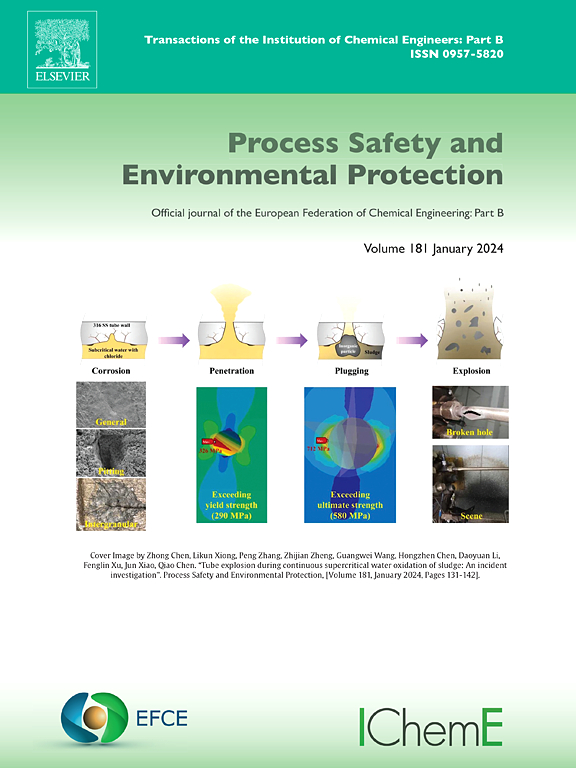Water and sediments pollution from Iza river (Romania): Influence on water quality and metals content
IF 6.9
2区 环境科学与生态学
Q1 ENGINEERING, CHEMICAL
引用次数: 0
Abstract
The present study introduces a monitoring initiative focused on the quality of surface water quality of the water samples collected from Iza and Tisa rivers, situated in the Sighetu Marmației locality in the Upper Tisa, a Natura 2000 protected area, in the North-West region of Romania. The study assessed the evolution of 15 chemical indicators (electric conductivity, pH, oxide-reduction potential, dissolved oxygen, total hardness, turbidity, fluoride, chloride, ammonium concentration (NH4+), nitrates (NO3-), nitrites (NO2-), sulphate (SO42-), Total Dissolved Solids, alkalinity (HCO3-, CO32-)), and 20 metals (Ag, Al, As, Ba, Ca, Cd, Co, Cr, Cu, Fe, K, Li, Mg, Mn, Na, Ni, Pb, Sb, Sr, Zn) in the water samples, and 12 metals in sediments collected from Isa river (As, Ba, Cd, Co, Cr, Cu, Fe, Mn, Ni, Pb, Sb, Zn), which were monthly measurement in the year of 2024. The objectives of this study were: (1) to assess the quality of Iza and Tisa rivers by measuring and analyzing the chemical load. (2) To identify the extent of the anthropogenic pressures and to elaborate measurements destined for mitigation of negative anthropogenic emission and environmental alterations. (3) To determine the typology of Iza river by applying the Total Ionic Salinity chart based on the major ions, Gibbs Piper and Ficklin-Caboi plots, indicating the precipitation, rock dominance, and silicate weathering, characterizing all studied surface waters. (4) To identify and evaluate the metal pollution in water and sediments, based on metal pollution index (MPI), and the human health risk at metals through variate risk indices (HQ and CDI). (5) To calculate the transfer of metals from Isa River to sediments, and to determine the ecological impact based on the enrichment factor and geoaccumulation index. Piper diagram indicated Ca-Na-HCO3- mixed typology, attributed to mineral solubilization or recharge water, and the Ficklin-Caboi chart indicated near-neutral high metal type of waters. According to the metal pollution indices scores, most surface waters (86 %) were characterized by medium pollution with the metals of interest. The mean scores varied between the critical range of 30–15, indicating medium pollution, MPI scores ranged between14.9–22.8 respectively. No human health risk at metals through ingestion for adults and children was determined, based on the hazard quotient scores which were lower than the critical value of one. Generally, the descendent trend associated to the transfer of metals from sediment to water was: Fe>Mn>As>Cu>Pb>Co>Cr>Sb>Ba>Ni>Cd>Zn. Generally, samples had a depletion to minimal enrichment with heavy metals (ER <2.0), especially with Cr, Fe, Ni, and Pb. All samples present significant enrichment (5.00 <EF<20) with Cd, while 70 % of samples present significant enrichment with Mn, and 57 % of sample were characterized by significant enrichment with Zn. Sediments were characterized by heavily contaminated with Cd, indicated by the Igeo scores. All sediments indicated Igeo scores lower than zero (Igeo<0), characterized by lack of contamination with As, Cr, Cu, Fe, Mn, Ni, Pb, and Zn. A comparative analysis of metals in water and sediments revealed notable connections between physico-chemical indicators and metal content. This analysis underscored the necessity for a customized conservation strategy. Correlation analyses revealed both positive and negative relationships between metal pairs. A comprehensive understanding of these parameters is imperative for effective water resource management and the preservation of biodiversity in the region. The findings of this study are advantageous in identifying the level of pollution in the Isa watercourse. They serve as an indicator for local authorities, prompting the implementation of measures to reduce pollution in the surrounding area. This is crucial for enhancing human health and preserving the ecosystems within the protected area.
伊扎河(罗马尼亚)的水和沉积物污染:对水质和金属含量的影响
本研究介绍了一项监测倡议,重点关注从罗马尼亚西北地区上Tisa保护区sigetu Marmației地区的Iza和Tisa河流收集的水样的地表水质量。研究评估了15种化学指标(电导率、pH值、氧化还原电位、溶解氧、总硬度、浊度、氟化物、氯化物、铵离子浓度(NH4+)、硝酸盐(NO3-)、亚硝酸盐(NO2-)、硫酸盐(SO42-)、总溶解固体、碱度(HCO3-、CO32-))、20种金属(Ag、Al、As、Ba、Ca、Cd、Co、Cr、Cu、Fe、K、Li、Mg、Mn、Na、Ni、Pb、Sb、Sr、Zn)和伊萨河沉积物中12种金属(As、Ba、Cd、Co、Co、Co)的演变。Cr, Cu, Fe, Mn, Ni, Pb, Sb, Zn),在2024年每月测量。本研究的目的是:(1)通过测量和分析化学负荷来评价伊扎河和蒂萨河的水质。(2)确定人为压力的程度,并制订旨在减轻负面人为排放和环境变化的测量措施。(3)利用基于主要离子的总离子盐度图、Gibbs Piper图和Ficklin-Caboi图确定伊扎河的类型,表明所有研究的地表水的降水、岩石优势和硅酸盐风化特征。(4)基于金属污染指数(MPI)识别和评价水体和沉积物中的金属污染,通过多元风险指数(HQ和CDI)识别和评价金属对人体的健康风险。(5)计算了伊萨河金属向沉积物的迁移量,并根据富集因子和地聚集指数确定了生态影响。Piper图显示Ca-Na-HCO3-混合类型,属于矿物增溶或补给水,Ficklin-Caboi图显示近中性高金属类型。根据金属污染指数得分,大多数地表水(86 %)的特征是中等污染和感兴趣的金属。平均得分在30-15的临界范围内变化,表明中等污染,MPI得分分别在14.9 - 22.8之间。根据低于临界值1的危险商数得分,没有确定通过摄入金属对成人和儿童造成的人体健康风险。总体上,沉积物中金属向水体转移的下降趋势为:Fe>;Mn>As>Cu>Pb>Co>Cr>Sb>Ba>Ni>Cd>Zn。一般来说,样品中重金属(ER <2.0),特别是Cr、Fe、Ni和Pb的富集程度从耗尽到最小。所有样品的Cd显著富集(5.00 <EF<20), 70 %的样品的Mn显著富集,57 %的样品的Zn显著富集。Igeo评分表明沉积物镉污染严重。所有沉积物的Igeo评分均低于零(Igeo<0),表现为缺乏As、Cr、Cu、Fe、Mn、Ni、Pb和Zn的污染。通过对水体和沉积物中金属的对比分析,揭示了理化指标与金属含量之间的显著联系。这一分析强调了定制保护策略的必要性。相关分析显示,金属对之间既有正相关,也有负相关。全面了解这些参数对于有效的水资源管理和保护该地区的生物多样性至关重要。这项研究的结果对确定伊萨水道的污染程度是有利的。它们是地方当局的一个指标,促使实施减少周边地区污染的措施。这对于增进人类健康和保护保护区内的生态系统至关重要。
本文章由计算机程序翻译,如有差异,请以英文原文为准。
求助全文
约1分钟内获得全文
求助全文
来源期刊

Process Safety and Environmental Protection
环境科学-工程:化工
CiteScore
11.40
自引率
15.40%
发文量
929
审稿时长
8.0 months
期刊介绍:
The Process Safety and Environmental Protection (PSEP) journal is a leading international publication that focuses on the publication of high-quality, original research papers in the field of engineering, specifically those related to the safety of industrial processes and environmental protection. The journal encourages submissions that present new developments in safety and environmental aspects, particularly those that show how research findings can be applied in process engineering design and practice.
PSEP is particularly interested in research that brings fresh perspectives to established engineering principles, identifies unsolved problems, or suggests directions for future research. The journal also values contributions that push the boundaries of traditional engineering and welcomes multidisciplinary papers.
PSEP's articles are abstracted and indexed by a range of databases and services, which helps to ensure that the journal's research is accessible and recognized in the academic and professional communities. These databases include ANTE, Chemical Abstracts, Chemical Hazards in Industry, Current Contents, Elsevier Engineering Information database, Pascal Francis, Web of Science, Scopus, Engineering Information Database EnCompass LIT (Elsevier), and INSPEC. This wide coverage facilitates the dissemination of the journal's content to a global audience interested in process safety and environmental engineering.
 求助内容:
求助内容: 应助结果提醒方式:
应助结果提醒方式:


